2015 HYUNDAI I40 light
[x] Cancel search: lightPage 502 of 534

Downloaded from www.Manualslib.com manuals search engine 797
Maintenance
High mounted stop light bulb
replacement (if equipped)
If the light does not operate, have the
vehicle checked by an authorized
HYUNDAI dealer.
License plate light bulb replace-
ment
1. Turn off the engine.
2. Loosen the retaining screws with aphilips head screwdriver.
3. Remove the bulb assembly by turning it counterclockwise.
4. Remove the bulb by pulling it straight out.
5. Install a new bulb.
6. Reinstall the bulb assembly securely with the retaining screws.
OVF071043OVF071042
Page 503 of 534
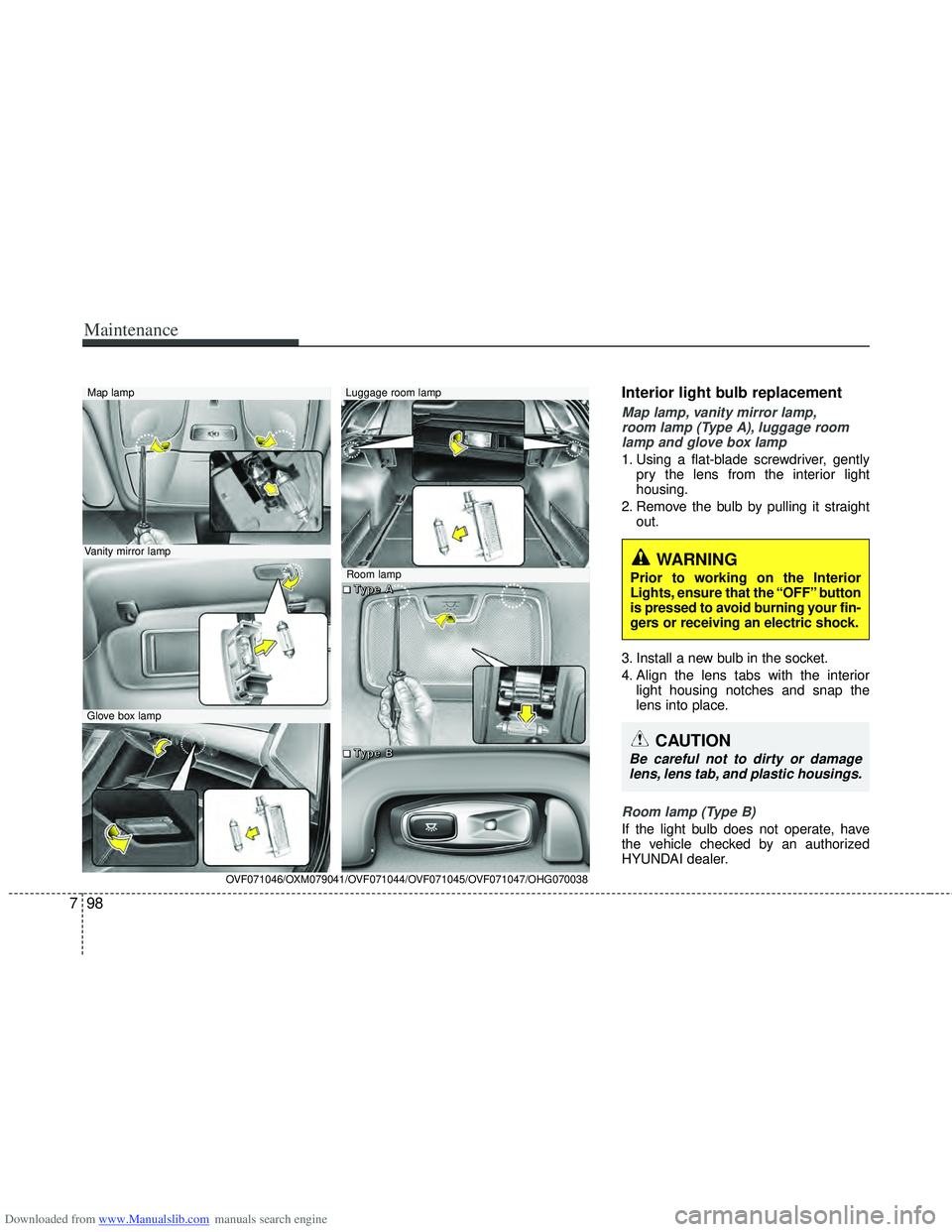
Downloaded from www.Manualslib.com manuals search engine Maintenance
98
7
Interior light bulb replacement
Map lamp, vanity mirror lamp,
room lamp (Type A), luggage room lamp and glove box lamp
1. Using a flat-blade screwdriver, gently pry the lens from the interior light
housing.
2. Remove the bulb by pulling it straight out.
3. Install a new bulb in the socket.
4. Align the lens tabs with the interior light housing notches and snap the
lens into place.
Room lamp (Type B)
If the light bulb does not operate, have
the vehicle checked by an authorized
HYUNDAI dealer.
WARNING
Prior to working on the Interior
Lights, ensure that the “OFF” button
is pressed to avoid burning your fin-
gers or receiving an electric shock.
CAUTION
Be careful not to dirty or damagelens, lens tab, and plastic housings.
Map lamp
Glove box lamp
Luggage room lamp
Vanity mirror lamp
Room lamp
OVF071046/OXM079041/OVF071044/OVF071045/OVF071047/OHG070038
■
■
■
■T
T
T
T
y
y
y
y
p
p
p
p
e
e
e
e
A
A
A
A
■
■
■
■T
T
T
T
y
y
y
y
p
p
p
p
e
e
e
e
B
B
B
B
Page 504 of 534
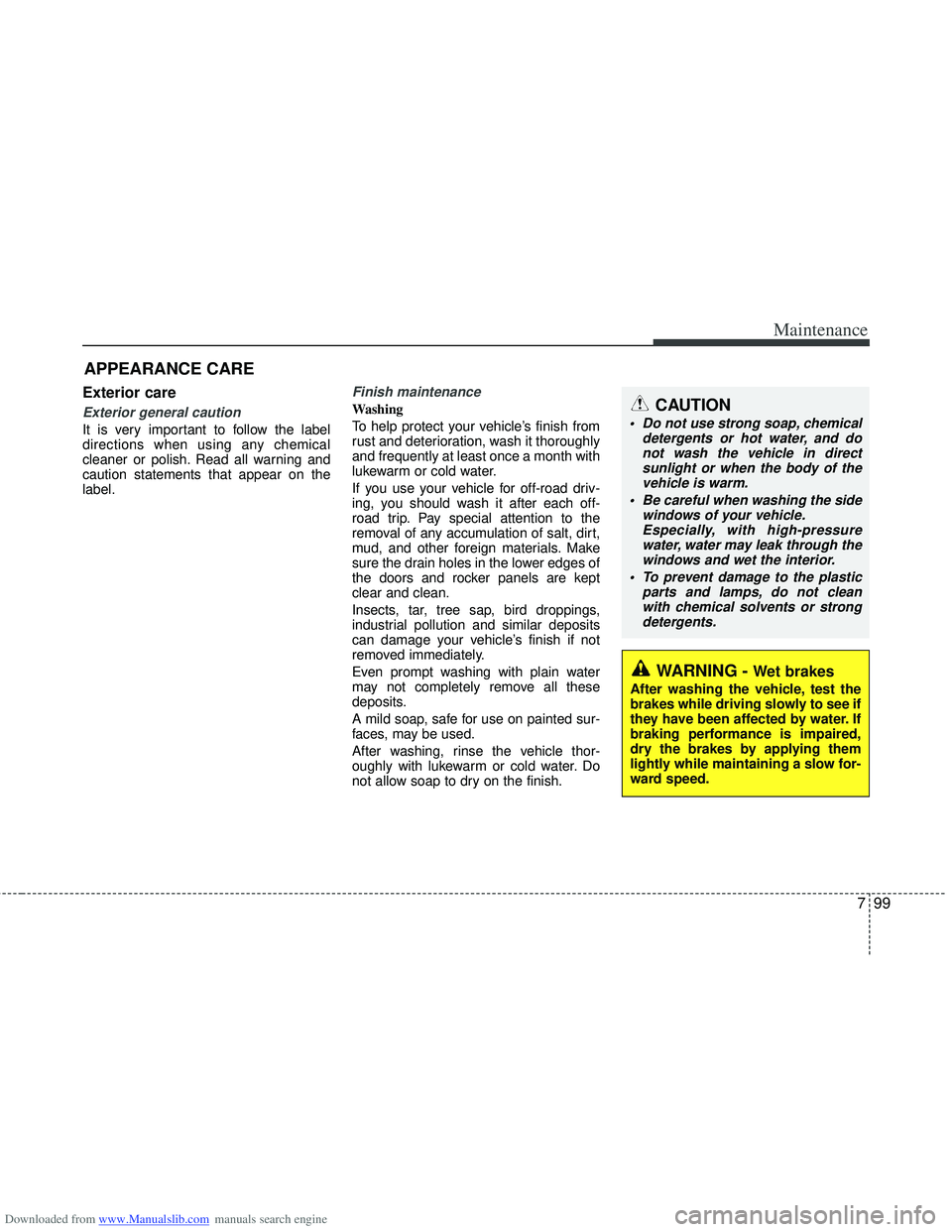
Downloaded from www.Manualslib.com manuals search engine 799
Maintenance
APPEARANCE CARE
Exterior care
Exterior general caution
It is very important to follow the label
directions when using any chemical
cleaner or polish. Read all warning and
caution statements that appear on the
label.
Finish maintenance
Washing
To help protect your vehicle’s finish from
rust and deterioration, wash it thoroughly
and frequently at least once a month with
lukewarm or cold water.
If you use your vehicle for off-road driv-
ing, you should wash it after each off-
road trip. Pay special attention to the
removal of any accumulation of salt, dirt,
mud, and other foreign materials. Make
sure the drain holes in the lower edges of
the doors and rocker panels are kept
clear and clean.
Insects, tar, tree sap, bird droppings,
industrial pollution and similar deposits
can damage your vehicle’s finish if not
removed immediately.
Even prompt washing with plain water
may not completely remove all these
deposits.
A mild soap, safe for use on painted sur-
faces, may be used.
After washing, rinse the vehicle thor-
oughly with lukewarm or cold water. Do
not allow soap to dry on the finish.
WARNING - Wet brakes
After washing the vehicle, test the
brakes while driving slowly to see if
they have been affected by water. If
braking performance is impaired,
dry the brakes by applying them
lightly while maintaining a slow for-
ward speed.
CAUTION
Do not use strong soap, chemicaldetergents or hot water, and donot wash the vehicle in direct sunlight or when the body of thevehicle is warm.
Be careful when washing the side windows of your vehicle.Especially, with high-pressurewater, water may leak through the windows and wet the interior.
To prevent damage to the plastic parts and lamps, do not cleanwith chemical solvents or strongdetergents.
Page 506 of 534

Downloaded from www.Manualslib.com manuals search engine 7101
Maintenance
Bright-metal maintenance
To remove road tar and insects, use atar remover, not a scraper or other
sharp object.
To protect the surfaces of bright-metal parts from corrosion, apply a coating of
wax or chrome preservative and rub to
a high luster.
During winter weather or in coastal areas, cover the bright metal parts with
a heavier coating of wax or preserva-
tive. If necessary, coat the parts with
non-corrosive petroleum jelly or other
protective compound.
Underbody maintenance
Corrosive materials used for ice and
snow removal and dust control may col-
lect on the underbody. If these materials
are not removed, accelerated rusting can
occur on underbody parts such as the
fuel lines, frame, floor pan and exhaust
system, even though they have been
treated with rust protection.
Thoroughly flush the vehicle underbody
and wheel openings with lukewarm or
cold water once a month, after off-road
driving and at the end of each winter. Pay
special attention to these areas because
it is difficult to see all the mud and dirt. It
will do more harm than good to wet down
the road grime without removing it. The
lower edges of doors, rocker panels, and
frame members have drain holes that
should not be allowed to clog with dirt;
trapped water in these areas can cause
rusting.WARNING
After washing the vehicle, test the
brakes while driving slowly to see if
they have been affected by water. If
braking performance is impaired,
dry the brakes by applying them
lightly while maintaining a slow for-
ward speed.
Page 512 of 534
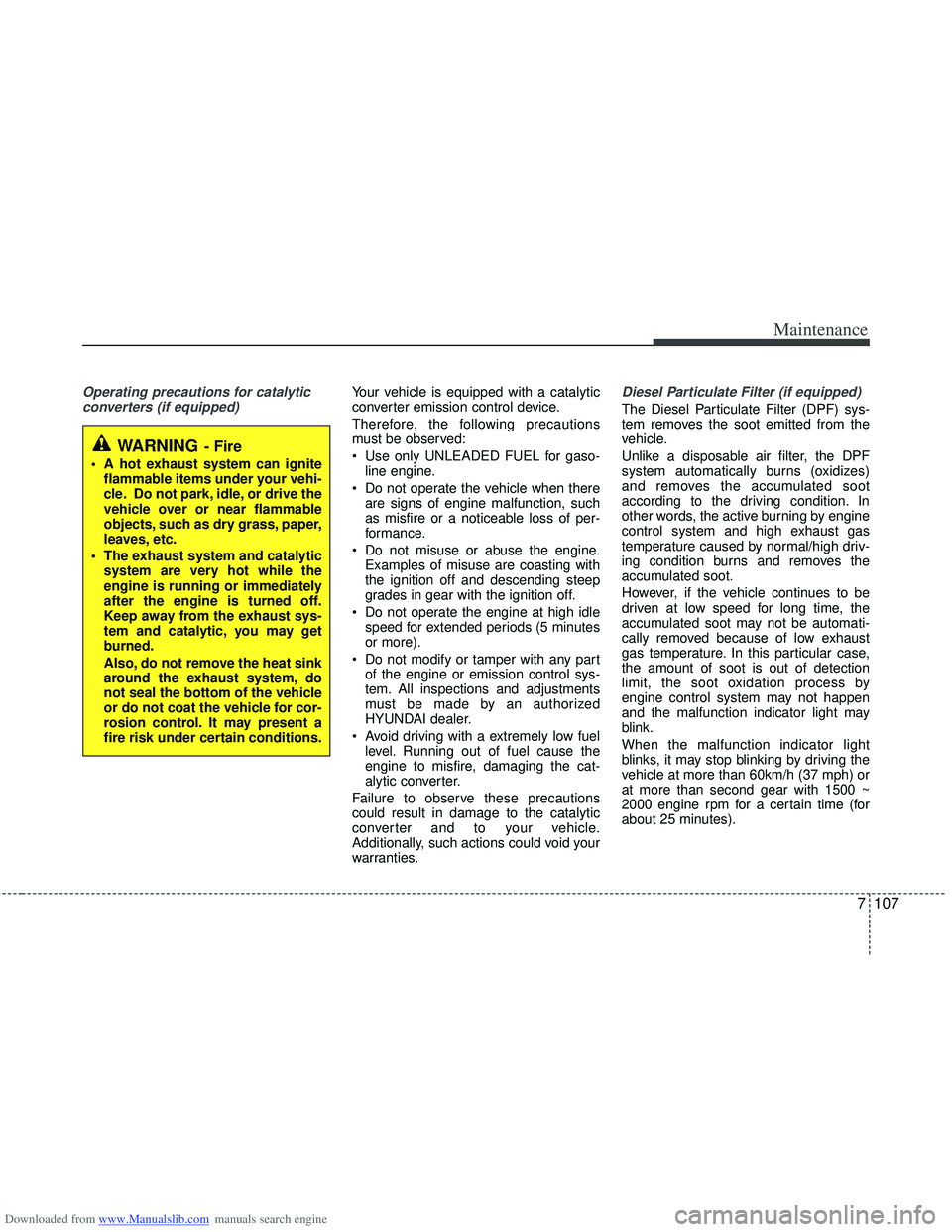
Downloaded from www.Manualslib.com manuals search engine 7107
Maintenance
Operating precautions for catalyticconverters (if equipped)Your vehicle is equipped with a catalytic
converter emission control device.
Therefore, the following precautions
must be observed:
Use only UNLEADED FUEL for gaso- line engine.
Do not operate the vehicle when there are signs of engine malfunction, such
as misfire or a noticeable loss of per-
formance.
Do not misuse or abuse the engine. Examples of misuse are coasting with
the ignition off and descending steep
grades in gear with the ignition off.
Do not operate the engine at high idle speed for extended periods (5 minutes
or more).
Do not modify or tamper with any part of the engine or emission control sys-
tem. All inspections and adjustments
must be made by an authorized
HYUNDAI dealer.
Avoid driving with a extremely low fuel level. Running out of fuel cause the
engine to misfire, damaging the cat-
alytic converter.
Failure to observe these precautions
could result in damage to the catalytic
converter and to your vehicle.
Additionally, such actions could void your
warranties.Diesel Particulate Filter (if equipped)
The Diesel Particulate Filter (DPF) sys-
tem removes the soot emitted from the
vehicle.
Unlike a disposable air filter, the DPF
system automatically burns (oxidizes)
and removes the accumulated soot
according to the driving condition. In
other words, the active burning by engine
control system and high exhaust gas
temperature caused by normal/high driv-
ing condition burns and removes the
accumulated soot.
However, if the vehicle continues to be
driven at low speed for long time, the
accumulated soot may not be automati-
cally removed because of low exhaust
gas temperature. In this particular case,
the amount of soot is out of detection
limit, the soot oxidation process by
engine control system may not happen
and the malfunction indicator light may
blink.
When the malfunction indicator light
blinks, it may stop blinking by driving the
vehicle at more than 60km/h (37 mph) or
at more than second gear with 1500 ~
2000 engine rpm for a certain time (for
about 25 minutes).
WARNING- Fire
A hot exhaust system can ignite flammable items under your vehi-
cle. Do not park, idle, or drive the
vehicle over or near flammable
objects, such as dry grass, paper,
leaves, etc.
The exhaust system and catalytic system are very hot while the
engine is running or immediately
after the engine is turned off.
Keep away from the exhaust sys-
tem and catalytic, you may get
burned.
Also, do not remove the heat sink
around the exhaust system, do
not seal the bottom of the vehicle
or do not coat the vehicle for cor-
rosion control. It may present a
fire risk under certain conditions.
Page 513 of 534
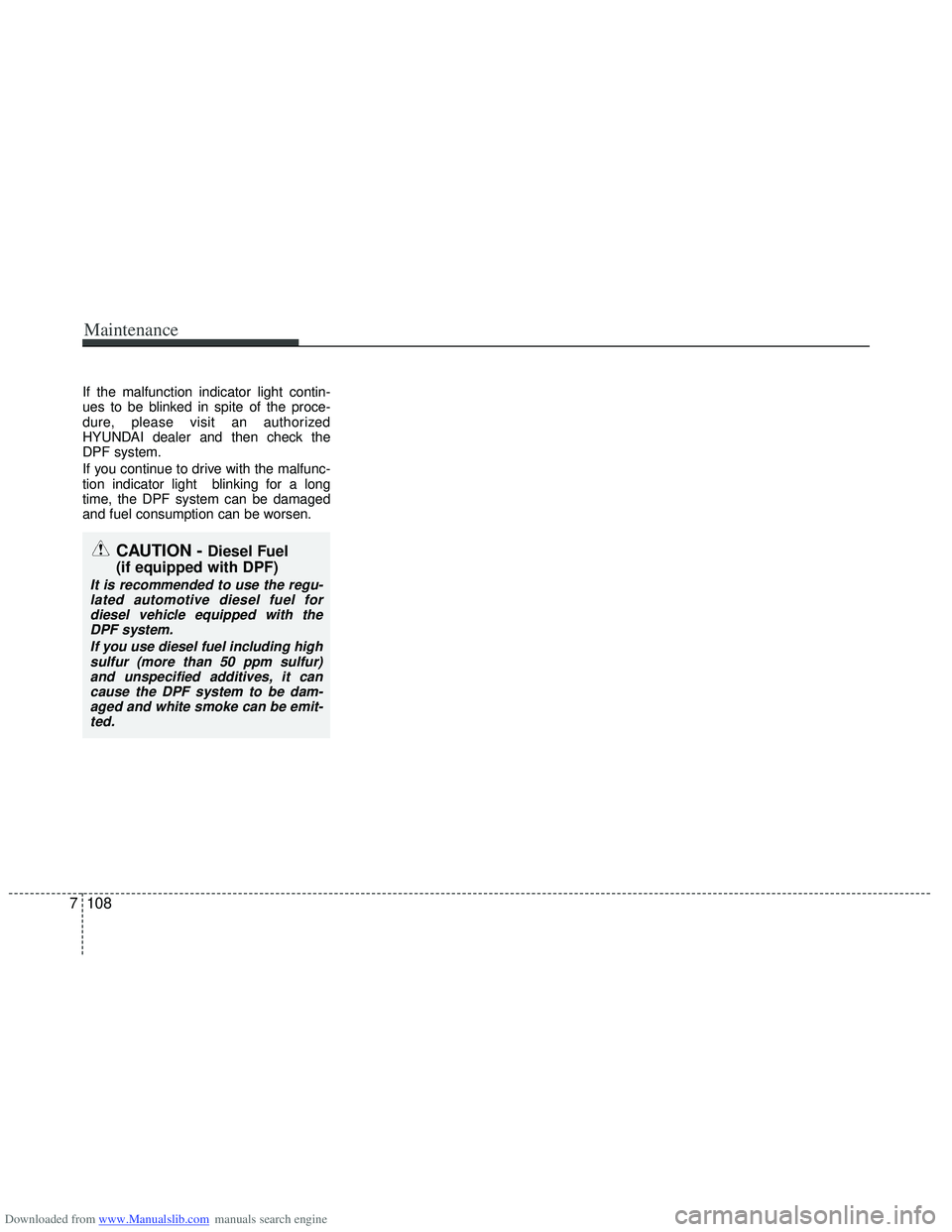
Downloaded from www.Manualslib.com manuals search engine If the malfunction indicator light contin-
ues to be blinked in spite of the proce-
dure, please visit an authorized
HYUNDAI dealer and then check the
DPF system.
If you continue to drive with the malfunc-
tion indicator light blinking for a long
time, the DPF system can be damaged
and fuel consumption can be worsen.
CAUTION - Diesel Fuel
(if equipped with DPF)
It is recommended to use the regu-
lated automotive diesel fuel fordiesel vehicle equipped with theDPF system.
If you use diesel fuel including highsulfur (more than 50 ppm sulfur) and unspecified additives, it cancause the DPF system to be dam-aged and white smoke can be emit-ted.
7108
Maintenance
Page 516 of 534
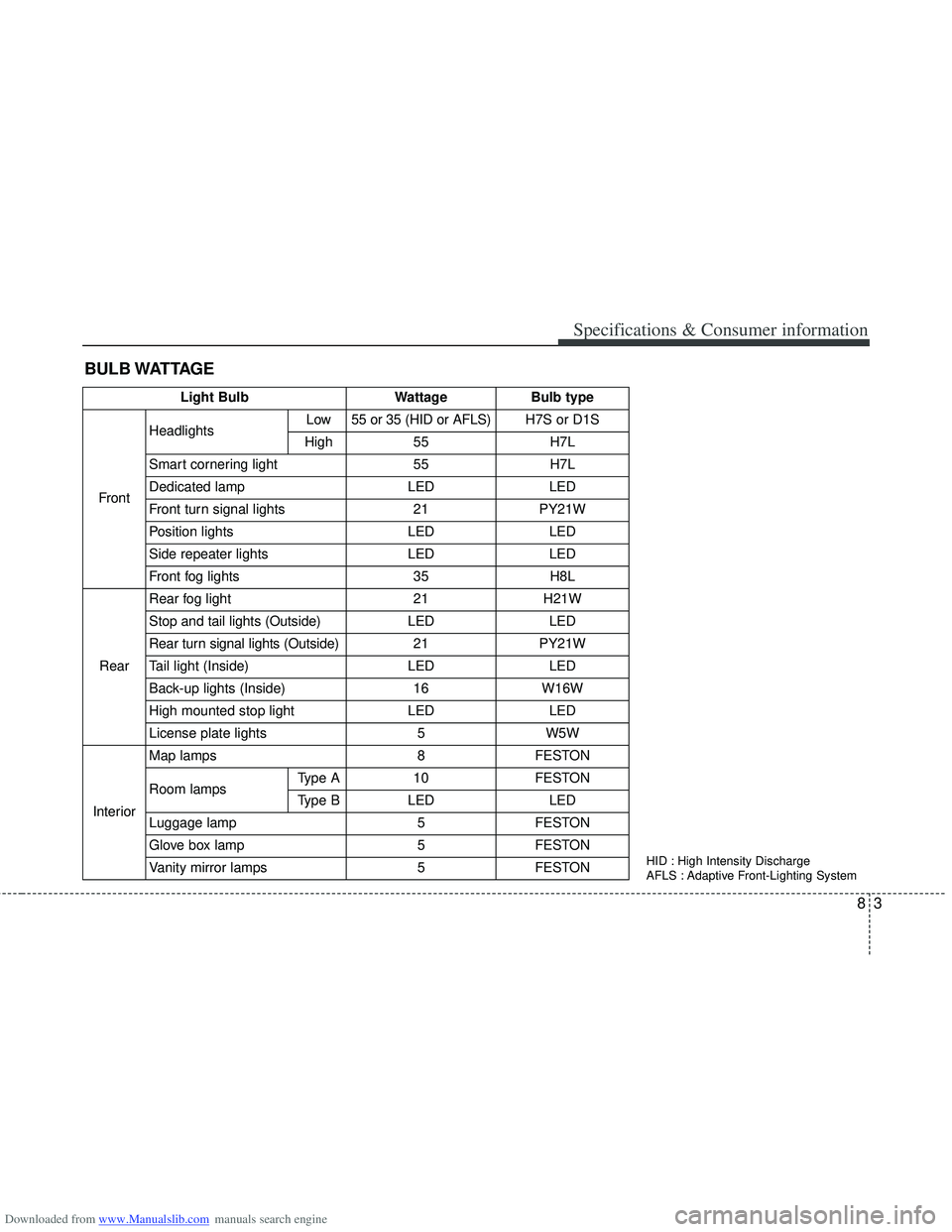
Downloaded from www.Manualslib.com manuals search engine 83
Specifications & Consumer information
BULB WATTAGE
Light BulbWattageBulb type
Front
HeadlightsLow55 or 35 (HID or AFLS)H7S or D1S
High55H7L
Smart cornering light55H7L
Dedicated lampLEDLED
Front turn signal lights21PY21W
Position lightsLEDLED
Side repeater lightsLEDLED
Front fog lights35H8L
Rear
Rear fog light21H21W
Stop and tail lights (Outside)LEDLED
Rear turn signal lights (Outside)21PY21W
Tail light (Inside)LEDLED
Back-up lights (Inside)16W16W
High mounted stop lightLEDLED
License plate lights5W5W
Interior
Map lamps8FESTON
Room lampsType A10FESTON
Type BLEDLED
Luggage lamp5FESTON
Glove box lamp5FESTON
Vanity mirror lamps5FESTONHID : High Intensity Discharge
AFLS : Adaptive Front-Lighting System
Page 525 of 534
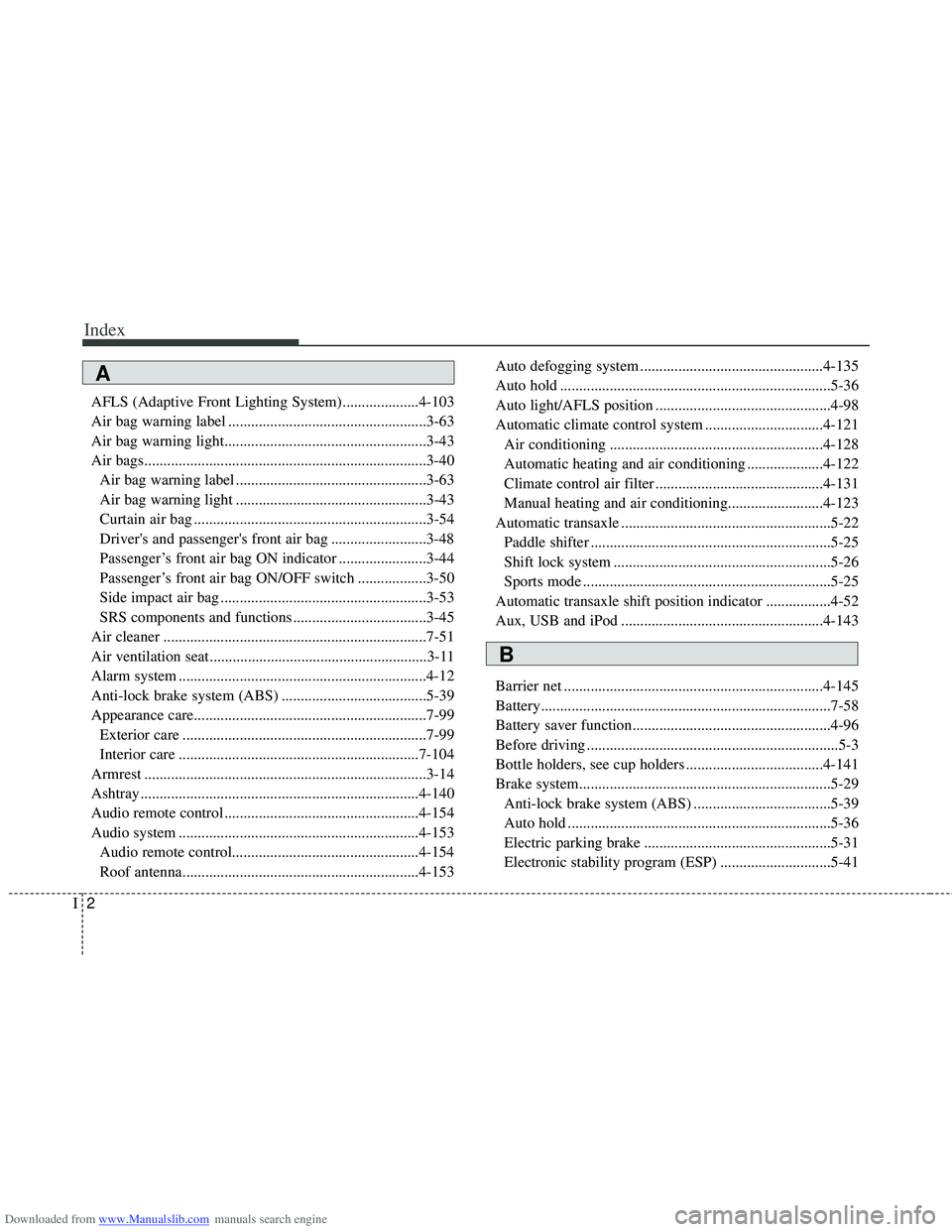
Downloaded from www.Manualslib.com manuals search engine Index
2I
AFLS (Adaptive Front Lighting System)....................4-103
Air bag warning label ....................................................3-63
Air bag warning light.....................................................3-43
Air bags........................................................................\
..3-40Air bag warning label ..................................................3-63
Air bag warning light ..................................................3-43
Curtain air bag .............................................................3-54
Driver's and passenger's front air bag .........................3-48
Passenger’s front air bag ON indicator .......................3-44
Passenger’s front air bag ON/OFF switch ..................3-50
Side impact air bag ......................................................3-53
SRS components and functions ...................................3-45
Air cleaner .....................................................................7-5\
1
Air ventilation seat .........................................................3-11
Alarm system .................................................................4-12
Anti-lock brake system (ABS) ......................................5-39
Appearance care.............................................................7-99 Exterior care ................................................................7-99
Interior care ...............................................................7-104
Armrest ........................................................................\
..3-14
Ashtray ........................................................................\
.4-140
Audio remote control ...................................................4-154
Audio system ...............................................................4-153 Audio remote control.................................................4-1\
54
Roof antenna..............................................................4-153 Auto defogging system ................................................4-135
Auto hold .......................................................................5\
-36
Auto light/AFLS position ..............................................4-98
Automatic climate control system ...............................4-121
Air conditioning ........................................................4-128
Automatic heating and air conditioning ....................4-122
Climate control air filter ............................................4-131
Manual heating and air conditioning.........................4-123
Automatic transaxle .......................................................5-22 Paddle shifter ...............................................................5-25
Shift lock system .........................................................5-26
Sports mode .................................................................5-25
Automatic transaxle shift position indicator .................4-52
Aux, USB and iPod .....................................................4-143
Barrier net ....................................................................4-14\
5
Battery........................................................................\
....7-58
Battery saver function....................................................4-96
Before driving ..................................................................5-3
Bottle holders, see cup holders ....................................4-141
Brake system..................................................................5-29 Anti-lock brake system (ABS) ....................................5-39
Auto hold .....................................................................5-3\
6
Electric parking brake .................................................5-31
Electronic stability program (ESP) .............................5-41
A
B